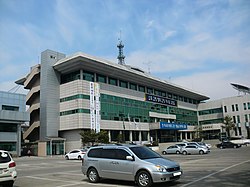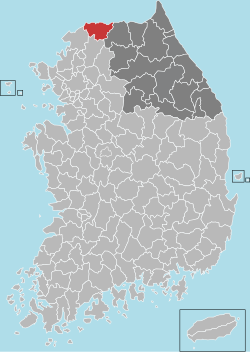This article includes a list of general references, but it lacks sufficient corresponding inline citations. (May 2020) |
Cheorwon County (Cheorwon-gun [ˈtɕʰʌ̹ɾwʌ̹n‿ɡun]), also spelled Chorwon, is a county in Gangwon Province, South Korea. It is located right next to the North Korean border.
Cheorwon
철원군 | |
|---|---|
| Korean transcription(s) | |
| • Hangul | 철원군 |
| • Hanja | 鐵原郡 |
| • Revised Romanization | Cheorwon-gun |
| • McCune-Reischauer | Ch'ŏrwŏn-gun |
 Cheorwon County Office | |
 Location in South Korea | |
| Country | |
| Region | Gwandong, Gyeonggi (before 1434) |
| Administrative divisions | 4 eup, 3 myeon |
| Area | |
| • Total | 899.82 km2 (347.42 sq mi) |
| Population (September 2024[1]) | |
| • Total | 40,646 |
| • Density | 60.05/km2 (155.5/sq mi) |
| • Dialect | Gangwon |
History
edit- Goguryeo – first named Moeuldongbi.
- Silla dynasty – name changed to Cheolseong.
- During the Later Three Kingdoms period of Korea, Gung Ye determined it capital of Taebong.
- Goryeo dynasty
- In 918, during the rule of King Taejo of Goryeo, its name was changed to Cheorwon and then renamed as Dongju.
- Joseon dynasty
- King Taejong changed its name into 'Dohobu'.
- In 26th year of King Sejong's reign (1434), it was transferred from Gyeonggi-do to Gangwon.
- On May 26 of the King Gojong, altered to Chuncheon-bu.[2]
Korean War
editFollowing the Division of Korea in 1945, all of Cheorwon County was part of North Korea.
During the Korean War the region changed hands several times during the UN invasion of North Korea and the Chinese invasion of South Korea, by 1951 the frontlines had stabilized, cutting across Cheorwon County and the area became part of the Iron Triangle. The Battle of Arrowhead Hill took place north of Cheorwon town from 6 to 10 October 1952 and the Battle of White Horse Hill took place north of Cheorwon town from 6 to 15 October 1952. The Battle of Triangle Hill took place north of Gimhwa-eup from 14 October to 25 November 1952.
Following the signing of the Korean Armistice Agreement, the Korean Demilitarized Zone divided Cheorwon County in two, creating Cheorwon County in South Korea and Chorwon County in North Korea, respectively.
Several Korean War sites in Cheorwon County are now tourist destinations including the former Woljeong-ri station, the former Korean Workers’ Party Office, the Iron Triangle Tourist Office, the Second Incursion Tunnel and the Cheorwon Peace Observatory.[3]
Civilian Control Line (CCL)
editThe Civilian Control Line is an additional buffer zone to the Demilitarized Zone (DMZ). The distance between the DMZ and CCL in South Korea ranges from 5 to 20 km (3.1 to 12.4 mi). The purpose is to limit and control the entrance of civilians into areas to protect and maintain the security of military facilities and operations near the DMZ.
Tourism
editFor South Korea, tourism has been important since the 1962 Five Year Development Plan. This designated a key economic development sector and a 'patriotic industry' (Hunter, 153). Historically nationalistic or patriotic perspectives have driven for the development of tourism in South Korea. Well organized tours and defined monuments and sites ensure these bordering areas are populated with visitors that participate in the symbolic landscape promoted by the South Korean government (Hunter, 153).
Described as "a scene of bloody battles" (n.d) and an area of tense border activity, the front-line county of Cheorwon presents a paradox. This historical county is infrequently visited by Western tourists. To understand the historical context of the Korean War, Cheorwon County offers significant insight into the conflict between North and South Korea.
The Second Tunnel
edit"Found in the DMZ" (n.d) was found by Korean guards listening to the sound of explosions under the ground during their shift. After determined excavation on March 19, 1975, "The Second Tunnel" was discovered. The second tunnel was for a sudden raid by the North Korean Army into South Korea. The second tunnel is composed of a firm granitic layer, is 3.5 km (2.17 mi) in length, and various in depth from 50m-160m (164 ft-525 ft).
Cheorwon Peace Observatory
edit"Cheorwon Peace Observatory" (n.d) is located at Junggang-ri, Dongsong-eup, South Korea. The Observatory is three stories high with a basement and was opened in November 2007. The observatory's first floor is the exhibition hall and the second floor is an observatory. Tourists on the second floor can observe the surrounding ecosystem, fortress of Gung-Ye Cast town, Pyeonggang tableland, and Seonjeon town of North Korea in the DMZ.
Memorial Tower of the Baekma Goji (White Horse) Battle
editDuring ten days of battle, the hill would change hands 24 times after repeated attacks and counterattacks for its possession. The original shape of the hill was transformed from more than 300,000 artillery shells and bombs. The destroyed ridge looked like a white horse lying down, so it was named Baekma Goji, meaning white horse hill.
Victory Observatory
edit"At the center of the 155 miles" (n.d) of the cease-fire line is the Victory Observatory. While visiting the Victory Observatory tourists can stare at Soldiers from the North Korean army, and the actual sites of the national division such as Geumgansan Railroad, Gwangasm Plain, and Achim-ri town.
Symbols
edit- County tree: Korean Nut Pine
- County flower: Royal Azalea
- County bird: Crane
Location
editCheorwon plays an important role in providing passage from Seoul to Wonsan and Kumgangsan.
Since the expansion of the 43 National Road which connects Cheorwon and Seoul, the ease of transportation has been improved greatly.[4]
Climate
editCheorwon has a monsoon-influenced humid continental climate (Köppen: Dwa).
| Climate data for Cheorwon (1991–2020 normals, extremes 1988–present) | |||||||||||||
|---|---|---|---|---|---|---|---|---|---|---|---|---|---|
| Month | Jan | Feb | Mar | Apr | May | Jun | Jul | Aug | Sep | Oct | Nov | Dec | Year |
| Record high °C (°F) | 13.1 (55.6) |
17.5 (63.5) |
22.4 (72.3) |
29.8 (85.6) |
32.5 (90.5) |
34.0 (93.2) |
36.0 (96.8) |
38.4 (101.1) |
33.7 (92.7) |
29.0 (84.2) |
24.0 (75.2) |
14.5 (58.1) |
38.4 (101.1) |
| Mean daily maximum °C (°F) | 0.7 (33.3) |
4.1 (39.4) |
10.2 (50.4) |
17.5 (63.5) |
22.9 (73.2) |
26.7 (80.1) |
28.1 (82.6) |
28.9 (84.0) |
25.0 (77.0) |
19.1 (66.4) |
10.5 (50.9) |
2.7 (36.9) |
16.4 (61.5) |
| Daily mean °C (°F) | −5.7 (21.7) |
−2.3 (27.9) |
3.7 (38.7) |
10.5 (50.9) |
16.6 (61.9) |
21.1 (70.0) |
23.8 (74.8) |
24.0 (75.2) |
18.9 (66.0) |
11.8 (53.2) |
4.3 (39.7) |
−3.2 (26.2) |
10.3 (50.5) |
| Mean daily minimum °C (°F) | −11.8 (10.8) |
−8.6 (16.5) |
−2.6 (27.3) |
3.4 (38.1) |
10.4 (50.7) |
16.1 (61.0) |
20.2 (68.4) |
20.1 (68.2) |
13.6 (56.5) |
5.5 (41.9) |
−1.2 (29.8) |
−8.6 (16.5) |
4.7 (40.5) |
| Record low °C (°F) | −29.2 (−20.6) |
−24.6 (−12.3) |
−13.4 (7.9) |
−8.2 (17.2) |
0.9 (33.6) |
6.1 (43.0) |
11.3 (52.3) |
8.8 (47.8) |
3.5 (38.3) |
−6.3 (20.7) |
−13.8 (7.2) |
−22.2 (−8.0) |
−29.2 (−20.6) |
| Average precipitation mm (inches) | 18.2 (0.72) |
26.3 (1.04) |
30.8 (1.21) |
69.0 (2.72) |
102.4 (4.03) |
119.0 (4.69) |
400.0 (15.75) |
347.4 (13.68) |
121.2 (4.77) |
49.9 (1.96) |
48.1 (1.89) |
22.1 (0.87) |
1,354.4 (53.32) |
| Average precipitation days (≥ 0.1 mm) | 6.3 | 6.0 | 7.3 | 8.1 | 9.1 | 10.9 | 16.6 | 14.3 | 8.4 | 6.6 | 8.1 | 7.5 | 109.2 |
| Average snowy days | 9.2 | 6.2 | 4.5 | 0.3 | 0.0 | 0.0 | 0.0 | 0.0 | 0.0 | 0.0 | 2.3 | 7.3 | 29.7 |
| Average relative humidity (%) | 67.1 | 63.1 | 60.5 | 58.3 | 64.4 | 71.4 | 81.3 | 81.4 | 76.9 | 72.9 | 71.6 | 70.0 | 69.9 |
| Mean monthly sunshine hours | 173.3 | 176.0 | 196.5 | 203.7 | 224.5 | 198.7 | 141.9 | 170.0 | 187.0 | 200.6 | 152.3 | 159.0 | 2,183.5 |
| Percent possible sunshine | 52.9 | 54.7 | 48.2 | 49.5 | 47.1 | 40.2 | 28.5 | 39.1 | 47.8 | 53.4 | 48.6 | 50.4 | 46.0 |
| Source: Korea Meteorological Administration (percent sunshine and snowy days 1981–2010)[5][6][7] | |||||||||||||
Sister cities
editSee also
editReferences
editNotes
- ^ "Population statistics". Korea Ministry of the Interior and Safety. 2024.
- ^ "Land of future! Dream of a thousand years!". 18 February 2013. Archived from the original on 18 February 2013.
- ^ "PLZ (Peace & Life Zone) Section 4 Cherwon". Korea Tourism Organization. Archived from the original on 1 July 2014. Retrieved 4 June 2013.
- ^ Welcome to Cheorwon county! ::[permanent dead link]
- ^ "Climatological Normals of Korea (1991 ~ 2020)" (PDF) (in Korean). Korea Meteorological Administration. pp. II-11, II-12, II-441. Archived from the original (PDF) on 29 January 2022. Retrieved 31 January 2022.
- ^ 순위값 - 구역별조회 (in Korean). Korea Meteorological Administration. Retrieved 5 October 2021.
- ^ "Climatological Normals of Korea" (PDF). Korea Meteorological Administration. 2011. p. 499 and 649. Archived from the original (PDF) on 7 December 2016. Retrieved 7 December 2016.
- ^ [서귀포시] 불편을 드려 죄송합니다.. www.seogwipo.go.kr.
Sources
- Cheorwon Peace Observatory. (n.d.). Retrieved December 7, 2018
- Cheorwon: Frontline Tourism. (November 5, 2015). Retrieved December 7, 2018
- Hunter, W. C. (2013). The Visual Representation of Border Tourism: Demilitarized Zone (DMZ) and Dokdo in South Korea. International Journal of Tourism Research,17(2), 151–160. doi:10.1002/jtr.1973
- Memorial Tower of the Baeckma Goji Battle. (n.d.). Retrieved December 9, 2018
- The Second Tunnel. (n.d.). Retrieved December 8, 2018
- Victory Observatory. (n.d.). Retrieved December 9, 2018
External links
edit- Cheorwon county government home page Archived 2017-06-14 at the Wayback Machine

